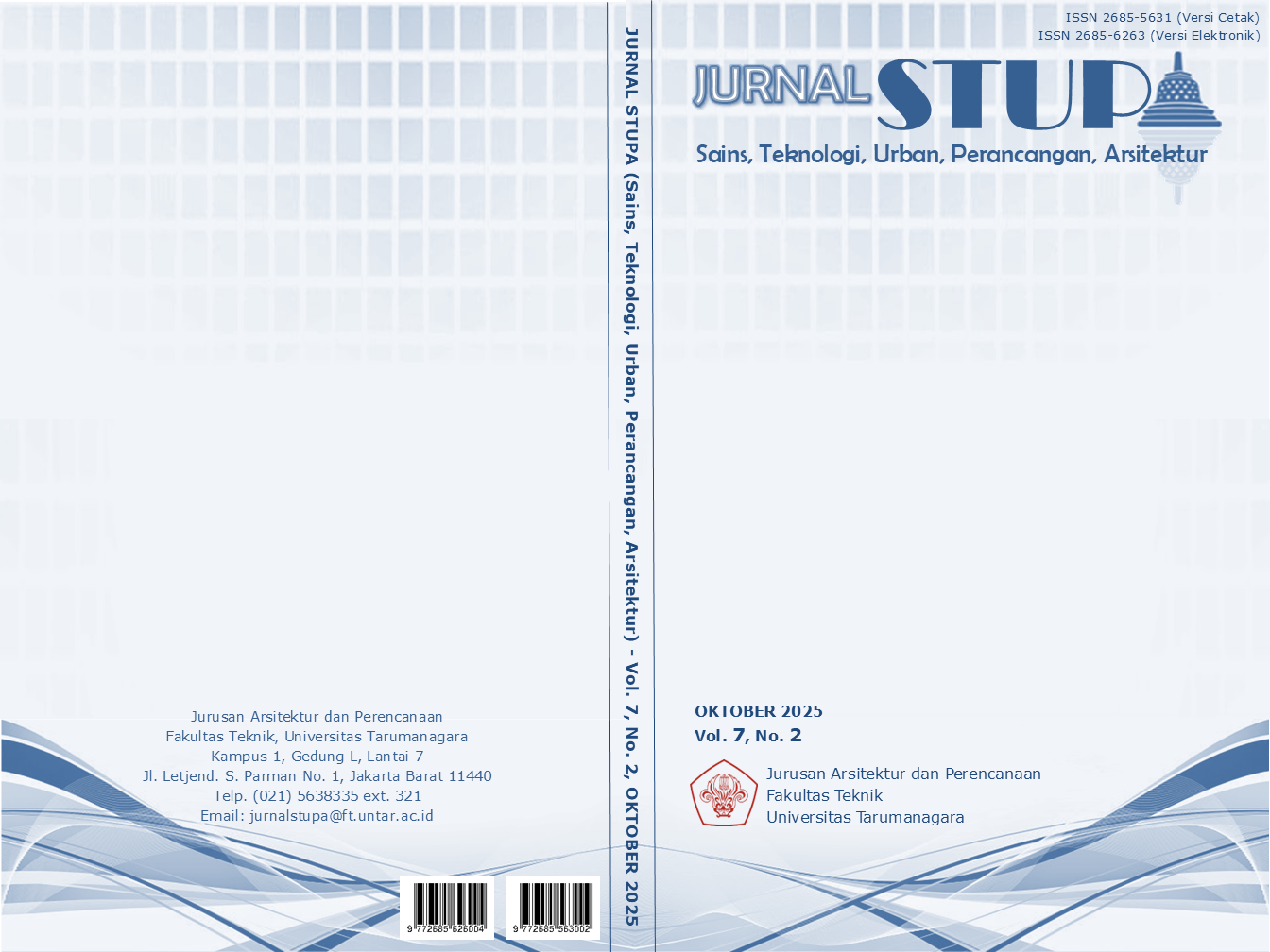MEREGENERASI HABITAT URBAN MELALUI PERANCANGAN ARSITEKTUR REGENERATIF UNTUK LEBAH DI JAKARTA SELATAN
Main Article Content
Abstract
The phenomenon of massive urban expansion in areas such as South Jakarta has led to the issue of habitat degradation and increasing ecological pressure on various pollinator species, particularly bees, which play a vital role in maintaining ecosystem balance. This research stems from the problem of how the characteristics of the built environment in urban areas affect the survival of bees, how architecture can represent the needs of other species, and what can be learned from bees in defining space, ecological relationships, and urban sustainability. The aim of this research is to identify the characteristics of the built environment that impact bee survival, and to explore the potential of regenerative architecture that can represent the needs of other species. Method used is descriptive qualitative analysis using a case study strategy focused on regenerative bee architecture. The research steps include site analysis, literature and case studies, field observation, concept formulation, and design development based on regenerative architectural principles for bees. The research results show that the characteristics of the built environment in South Jakarta—such as green space fragmentation and ecological pressure—negatively affect bee survival. The findings reveal that integrating regenerative architectural principles with the spatial behavior of bees can create adaptive spaces that support ecosystems. The novelty of this study lies in its design approach that positions bees as subjects of design, and in the application of regenerative concepts in the apiary zone, where bee activity cycles and spatial machines allow visitors to experience the product directly.
Keywords: apiary; bees; biophilic; regenerative
Abstrak
Fenomena ekspansi ruang kota yang masif di kawasan urban seperti Jakarta Selatan telah menyebabkan isu degradasi habitat alami dan tekanan ekologis bagi berbagai spesies polinator, khususnya lebah, yang memiliki peran vital dalam menjaga keseimbangan ekosistem. Penelitian ini bertolak dari permasalahan: bagaimana karakteristik lingkungan binaan urban mempengaruhi keberlangsungan hidup lebah, serta bagaimana arsitektur dapat merepresentasikan kebutuhan spesies lain, dan apa yang dapat dipelajari dari lebah dalam mendefinisikan ruang, relasi ekologis, dan keberlanjutan kota. Tujuan penelitian ini adalah mengidentifikasi karakteristik lingkungan binaan yang berdampak terhadap keberlangsungan hidup lebah, serta mengeksplorasi potensi arsitektur regeneratif yang mampu merepresentasikan kebutuhan spesies lain. Metode yang digunakan adalah kualitatif deskriptif dengan strategi studi kasus, yang berfokus pada arsitektur regeneratif untuk lebah. Langkah penelitian meliputi analisis tapak, studi literatur dan kasus, observasi lapangan, perumusan konsep, dan perancangan berbasis prinsip arsitektur regeneratif. Hasil penelitian menunjukkan bahwa karakteristik lingkungan binaan di Jakarta Selatan, seperti fragmentasi ruang hijau dan tekanan ekologis, berdampak negatif terhadap keberlangsungan lebah. Temuan penelitian mengungkap bahwa integrasi prinsip arsitektur regeneratif dengan perilaku spasial lebah mampu menciptakan ruang yang adaptif dan mendukung ekosistem. Kebaruan penelitian ini terletak pada pendekatan desain yang menjadikan lebah sebagai subjek perancangan serta penerapan konsep regeneratif pada zona apiary di mana terdapat siklus aktivitas lebah, serta penerapan spatial machine yang memungkinkan pengunjung merasakan produk secara langsung.
Article Details

This work is licensed under a Creative Commons Attribution-NonCommercial-ShareAlike 4.0 International License.
This work is licensed under a Jurnal Sains, Teknologi, Urban, Perancangan, Arsitektur/ STUPA Creative Commons Attribution-NonCommercial-ShareAlike 4.0 International LicenseReferences
Andreucci, M., Loder, A., McGee, B., Brajković, J., & Brown, M. (2021). Exploring Regenerative Co-benefits of Biophilic Design for People and the Environment. In C. Catalano, M. Andreucci, R. Guarino, F. Bretzel, M. Leone, & S. (. Pasta, Urban Services to Ecosystems (Vol. 17). Springer.
Armstrong, R. (2023). Introducing Regenerative Architecture. Journal of Chinese Architecture and Urbanism, 6(1), 1882.
Buchori, D., Priawandiputra, W., Kahono, S., Raffiudin, R., Putra, R. A., ., .. .., & Sartiami, D. (2023). Strategi Konservasi dan Pelestarian Lebah di Indonesia. Policy Brief Pertanian, Kelautan, dan Biosains Tropika, 5(3), 1-5.
Chrisdamayanti, R., & Samadi. (2023). Ruang Terbuka Hijau Kebutuhan Tata Ruang Perkotaan Kota Administrasi Jakarta Selatan Provinsi DKI Jakarta.
Devi, A. C., & Jeyaradha, J. (2023). The New Green Regenerative Architecture. IOP Conference Series, 1210.
Dias, B. D. (2015). Beyond Sustainability - Biophilic and Regenerative Design in Architecture. European Scientific Journal.
El-Didamony, S. E., Gouda, H. I., Zidan, M. M., & Amer, R. I. (2024). Bee Products: An Overview of Sources, Biological Activities and Advanced Approaches Used in Apitherapy Application. Science Direct, 44.
Glenny, W., Runyon, J. B., & Burkle, L. A. (2023). Habitat characteristics structuring bee communities in a forest-shrubland ecotone. Forest Ecology and Management, 534.
Prabowo, R., Bambang, A. N., & Sudarno. (2020). Pertumbuhan Penduduk dan Alih Fungsi Lahan Pertanian. Mediagro, 16(2), 26-36.
Pradeep, S., Yadav, A. K., Ray, S., & Saikanth, D. (2024). The Fascinating Life of Bees. Recent Trends in Entomology, 46-59.
Rahmad, B., Damiri, N., Hanafiah, Z., Adriani, D., & Hanum, L. (2024). Food Source Diversity and Honey Production in Stingless Bee Meliponiculture, Ogan Komering Ulu Timur, South Sumatra, Indonesia. Biodiversitas, 25(6), 2747-2756.
Rong, C., & Sadhukhan, S. (2021). Decline of Bees, a Major Pollinator - A Review. BKGC SCHOLARS, 2(2), 35-43.
Sharma, C., Kumar, R., Srivastava, M., Kumar, M., Dr, R., Singh, R., . . . Rao, S. (2021). Beekeeping.
Sobreiro, A. I., Peres, L. L., Henrique, J. A., Mussury, R. M., & & Alves-Junior, V. V. (2021). Recover and They’ll Come: Flower Visiting Bees Benefit from the Continuous of MicroEnvironments Set by Regenerating Forest Fragments. Sociobiology, 68(1).
Trianto, M., T., A., P. H., & & Ubaidillah, R. (2023). Updated Species Check-list of the Indonesian Stingless Bees (Hymenoptera, Apidae, Apinae, Meliponini). Journal of Tropical Biodiversity and Biotechnology, 8(2), 1-24.
Zattara, E. E., & Aizen, M. A. (2021). Worldwide Occurrence Records Suggest a Global Decline in Bee Species Richness. One Earth, 4(1), 114-123.



